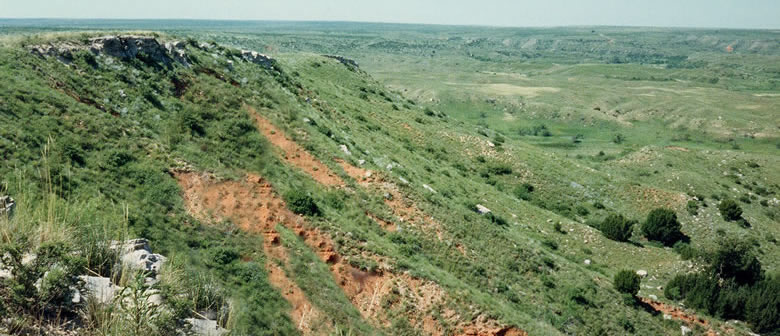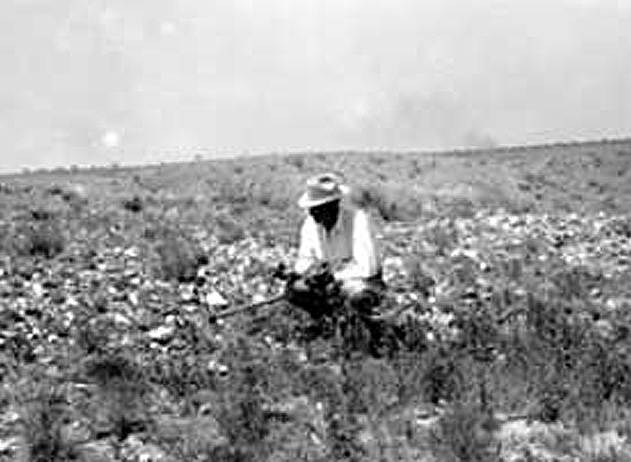
In this circa 1930s photo, an early
researcher tests Alibates flint amid thick scatters
of quarry debris. Photo by A. T. Jackson.
|
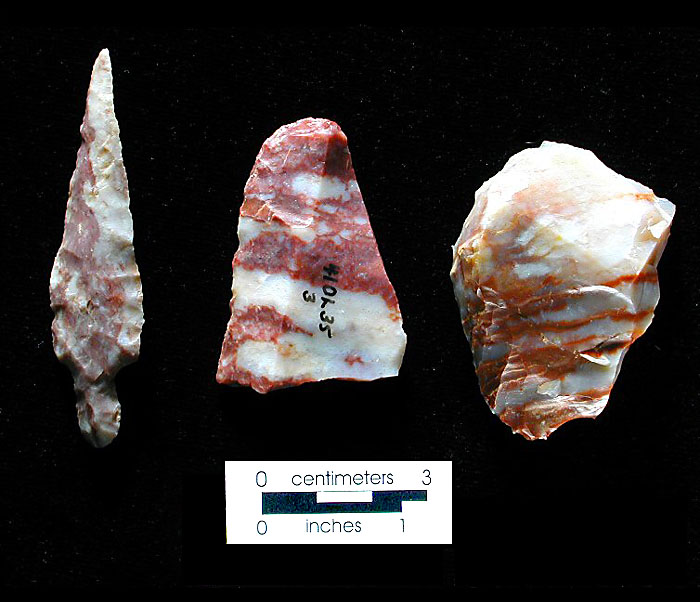
These reddish stones may have been
chosen by ancient knappers for their unusual banding.
The bifacial tool in the center has the look of beefsteak.
Photo by Milton Bell.
|
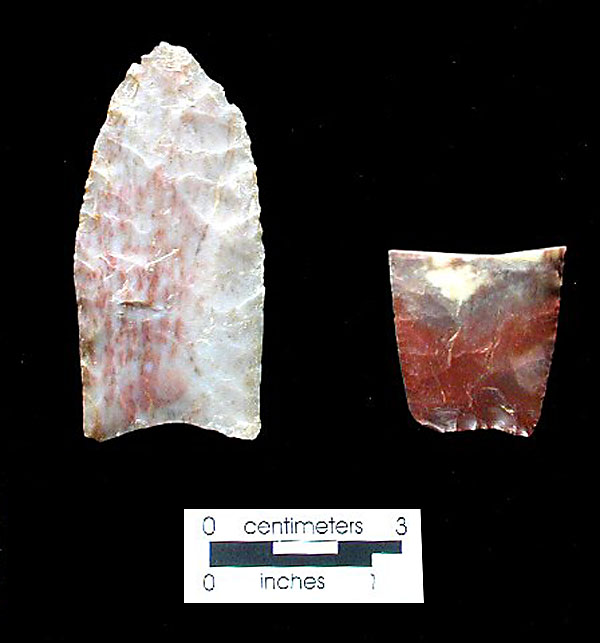
Paleoindian dart tips of Alibates
flint. A Clovis point (left) and broken base of another
show types of stone chosen by occupants of the Blackwater
Draw site. Photo by Milton Bell.
|
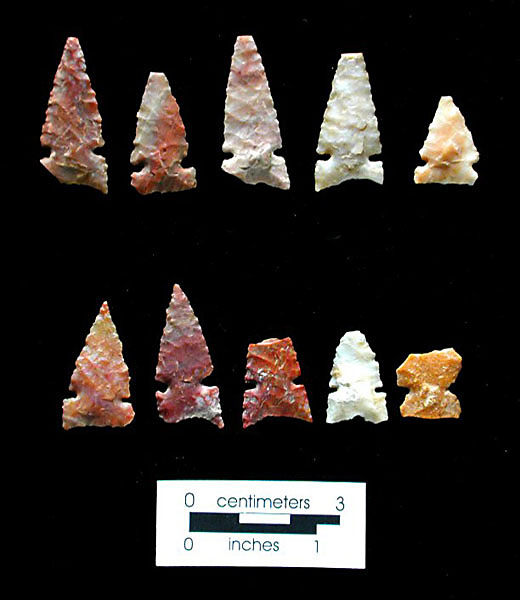
These colorful Alibates flint arrow
points were made by Late Prehistoric folk who lived
and hunted in the area around 800 years ago. Photo by
Milton Bell.
|
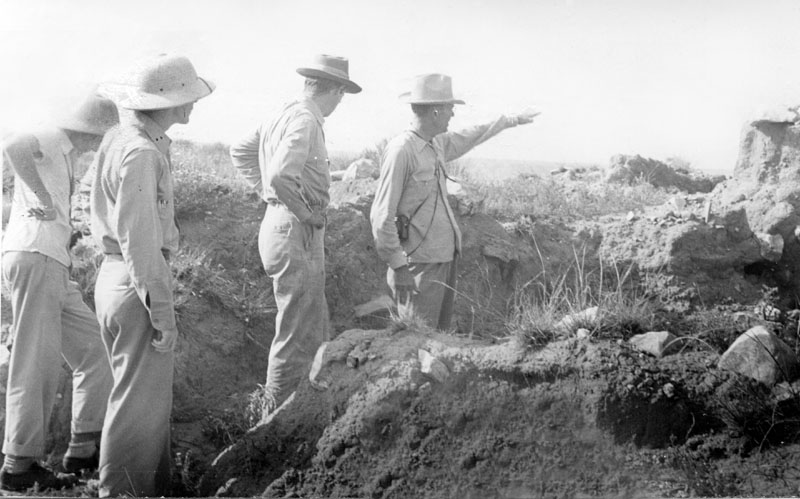
Floyd Studer points across still-open trenches at Alibates 28 during aJuly 26, 1945 visit by archeological dignitaries. Behind Studer from right to left: Alex Krieger, Clarence Webb, and Clarence Webb, Jr. Photo from TARL Archives.
|
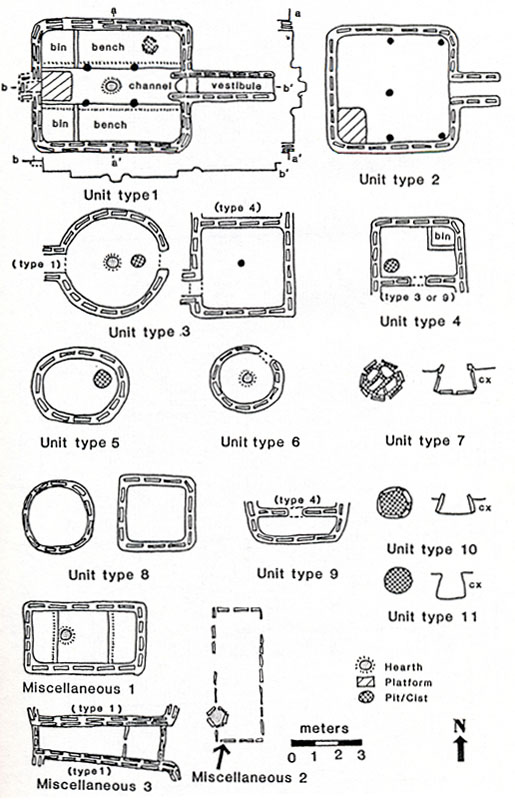
Variations in architecture in Antelope
Creek dwellings, as identified through a study of the
excavated ruins by Dr. Christopher Lintz . Drawing courtesy
of Dr. Lintz and the Oklahoma Archeological Survey.
|
|
Along the sloping canyon rims of the Canadian River
Valley in the Texas Panhandle are signs of an industry that
has spanned the course of human history in North America.
Small pits and literally tons of stone manufacturing debris
bear mute testimony to perhaps 13,000 years of quarrying a
brilliantly colored stone known as Alibates flint. So prized
was the material that prehistoric hunters traveled—or
traded—over distances of a thousand miles or more to
obtain it. Projectile points and other tools made of Alibates
stone have been found in sites as far north as Montana, as
far south as Central Mexico, and east to at least the Mississippi
River.
Archeologists for years have puzzled over the
scale and range of prehistoric activities that created these
remarkable sites. It is likely that some workers in search
of flint merely picked up exposed chunks or cobbles lying
on the ground. In fact, knappable cobbles of Alibates have
eroded down the Canadian River into western Oklahoma and as
far as Fort Smith, Arkansas. Other, more enterprising, workers
chiseled boulders directly from the bedrock. Their quarrying
activities left holes ranging from small depressions to broad
pits ranging from 5 to 20 feet across and up to 2 feet deep.
But what catches the eye for hundreds of yards beyond the
pit perimeters are the quarry wastepiles and tool-making debris
blanketing the hillslopes: thousands of quarried chunks, tested
cobbles, flakes, and tools in various stages of production.
Although termed "flint," the stone
is technically a silicified or agatized dolomite occurring
in Permian-age outcroppings. These deposits, exposed as slightly
undulating layers, are unique to the Panhandle area. But regardless
of what the stone is called, none of the terms captures its
startling beauty. In hues and tones of the evening sky, colors
range from pale gray and white, to pink, maroon, and vivid
red, to orange-gold and an intense purplish blue.
Patterns in the stone are varied as well. Bands
of alternating color create stripes and a marbled effect.
Researchers have speculated about the statistically significant
occurrence of red Alibates in sites, and whether the color
might have invoked magical connections to the blood of animals.
Clearly it was the exotic appearance of Alibates flint rather
than its workability that attracted prehistoric toolmakers.
Modern-day knappers report that the material has a resistant
quality and hardness which makes it more difficult to flake
and shape into tools than other stone, such as the Edwards
cherts found abundantly in the Edwards Plateau to the south.
Trade or Travel?
Based on evidence at the Alibates locale and at sites
further afield, prehistoric peoples throughout the millennia have
used stone from the quarry to make tools and weapons. Late ice-age
hunters apparently sought the material to tip the weapons used to
kill now-extinct large game animals. Finely flaked and fluted Alibates
flint projectile points were found at the Blackwater Draw site in
eastern New Mexico. The scene of a mammoth kill, the site dates
to 13,000 years ago at its earliest level.
Prehistoric hunters about a thousand years later
left behind Alibates flint projectile points of a different
style as well as a variety of other tools at the Plainview
site in what is now Hale County, Texas.
There is more evidence to suggest that later visitors to the quarry
mined the quarry stone more intensively than their forebears. They
used Alibates flint to outfit all parts of their "toolkit"
as well as to trade for other materials from other areas.
Ruins of Early Villages
Near the quarry site and along the Canadian River
valley are ruins of complex slabhouses and small villages attributed
to the later peoples who lived in the area from about A.D. 1150
to 1450 or later. Their culture, termed the Antelope Creek phase
by archeologists, is believed to have developed from indigenous
Plains Woodland groups who moved south into what is today the Texas-Oklahoma
panhandle region. Some researchers believe the migrants were drawn
by the water reserves of the Ogallala aquifer. The Antelope Creek
folk built their homes and hamlets close to springs or near the
river and were able to cultivate crops—beans, corn, and squash—on
a small scale. Nonetheless, hunting and gathering remained an important
part of their livelihood.
Various farming-related artifacts and other types of evidence speak to a transitional time in the
area's cultural history when hunting and gathering peoples became
more settled, planting small fields, making pottery, and trading
within large networks. In exchange for Alibates chert and bison
products, Antelope Creek people received painted pottery, shell
and turquoise jewelry, pipes, and obsidian from groups in the southwest
and to the north.
Archeologist Dr. Christopher Lintz has conducted an
extensive study of the Antelope Creek culture, tracking changes
over time in the size, architecture, interiors, and lay-out of Antelope
Creek houses and hamlets. His studies—some based on WPA-era
excavations of ruins at Alibates—reveal complex and interesting
modifications within house interiors that would not be evident to
visitors to the ruins today. These features clearly were designed
to improve daily work and comfort as well as to stave off the vicissitudes
of nature. In some houses, stone benches lining the walls were perhaps
used for sleeping and work platforms; storage pits were filled with
foodstuffs in advance of winter. Central hearths were used for cooking
as well as to provide warmth, whereas entryways, or vestibules,
were carefully designed to trap cold air. In some houses, recessed
floor channels extend from the doorway through the center of the
house, encompassing the central hearth, and ending in a raised platform
perhaps designed as an altar. Lintz believes these channels were
dug to contain debris from the work area activities and prevent
it from spreading into the sleeping areas. In all, Lintz identified
11 different patterns of house types.
Today, these important village ruins and quarry
sites are protected and preserved, thanks to the efforts and
foresight of the Potter County Historical Survey Committee
and concerned individuals. In the early 1960s, then-vice-chairman
Harry Hertner mounted an extensive campaign to bring the site
to the attention of Congress. With letters of support from
noted archeologists across the country and with Sen. Ralph
Yarborough and Rep. Walter Rogers carrying the legislation,
the Alibates flint quarries were established as a national
monument, the only such site in Texas. The Visitor Center for Alibates Flint Quarries National Monument is on Cas Johnson Road off of Highway 136 between Amarillo and Fritch, Texas. Arrangements for tours of the quarries Monday-Friday may be made by calling 806-857-3151. More information is available on the NPS website.
|
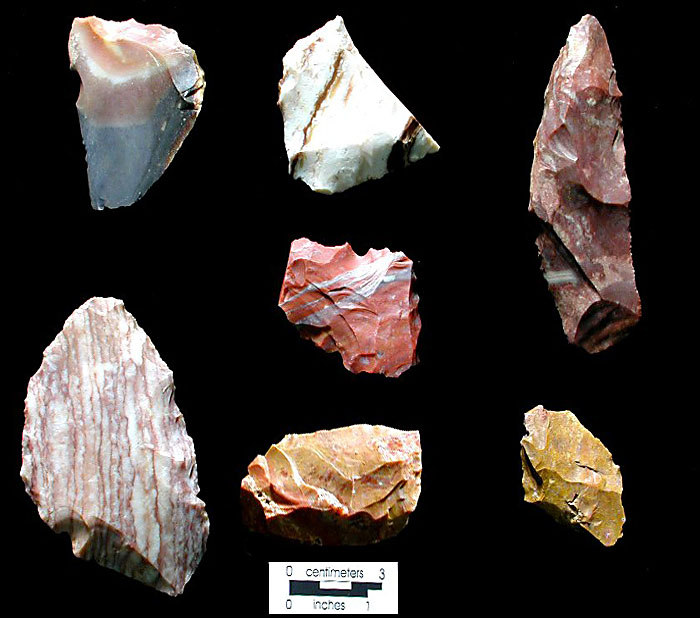
Unusual colors are a trademark of
Alibates flint. Photo by Milton Bell.
Click images to enlarge
|
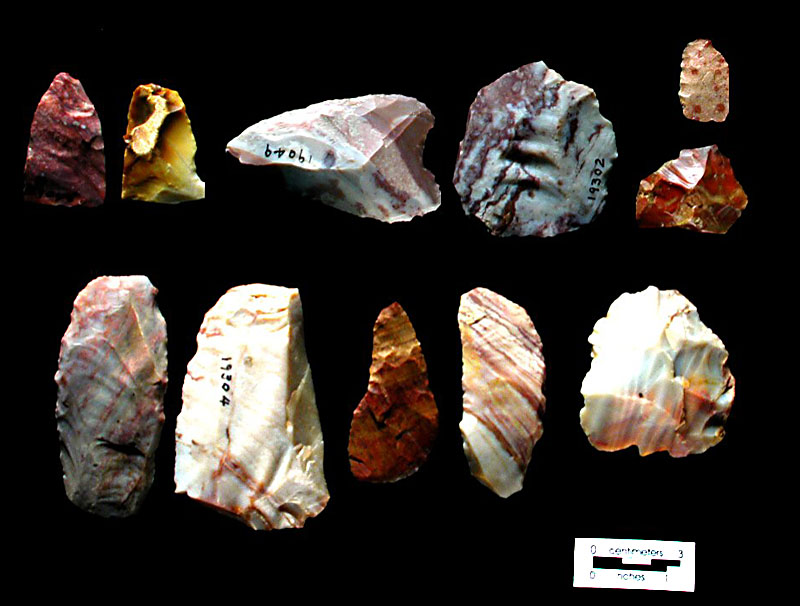
Other stones have speckled concentrations
of color creating mottled or parti-colored patterns.
Photo by Milton Bell.
|
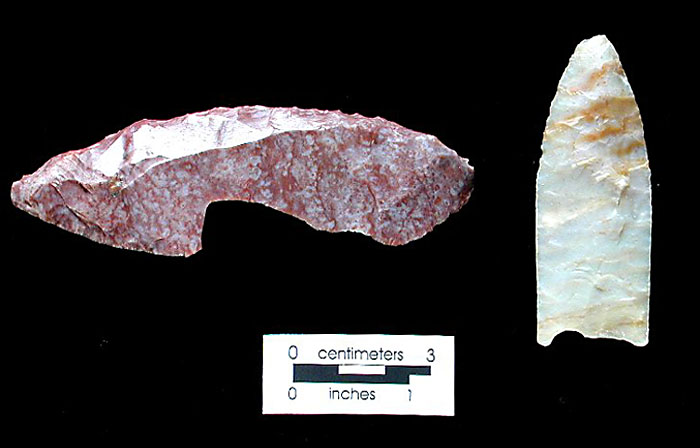
A large mottled-red cutting blade
(left) and dart point of white Alibates were among artifacts
found at the Plainview site. Photo by Milton Bell.
|
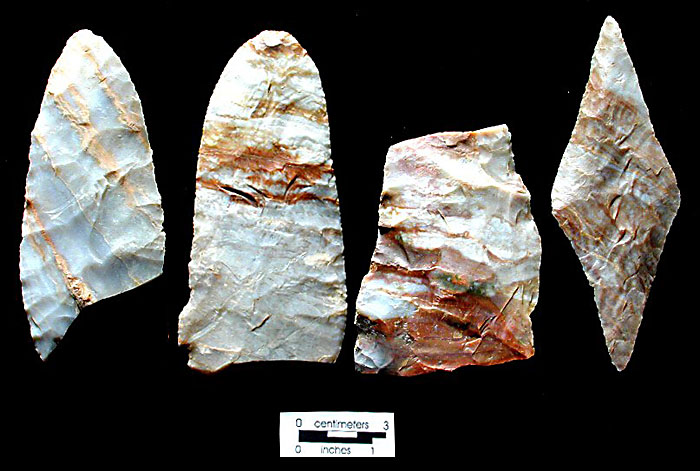
Game might have been butchered and
processed with large, beveled-edged knives such as these
of banded-white Alibates flint. Photo by Milton Bell.
|
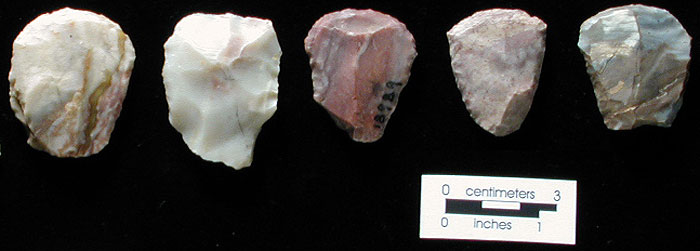
Hide-scraping and other tasks could
have been accomplished with these small, steeply edged
flake tools which some archeologists term "thumbnail
scrapers." Photo by Milton Bell.
|
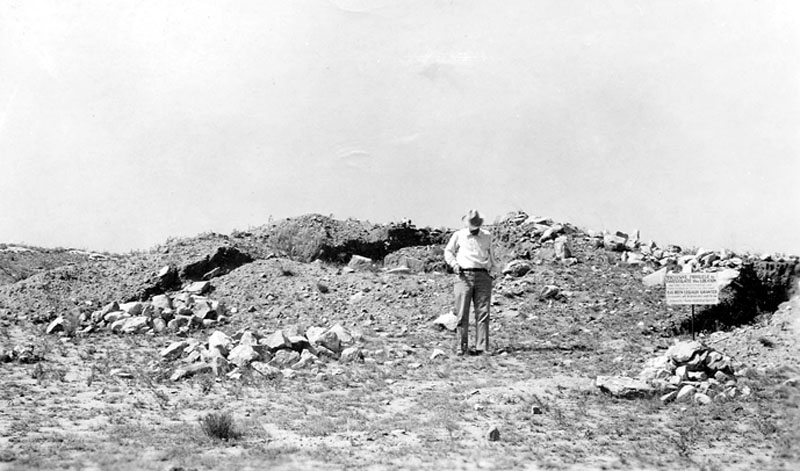
Floyd Studer poses in front
of Alibates Ruin 28. The image label reads: "Partly excavated pueblo
ruin (digging by Studer, Mason, Moorehead, et al.) Photo
by A.T. Jackson, 1935." The sign on the far right warns trespassers
against disturbing the site. Photo from
TARL Archives.
|
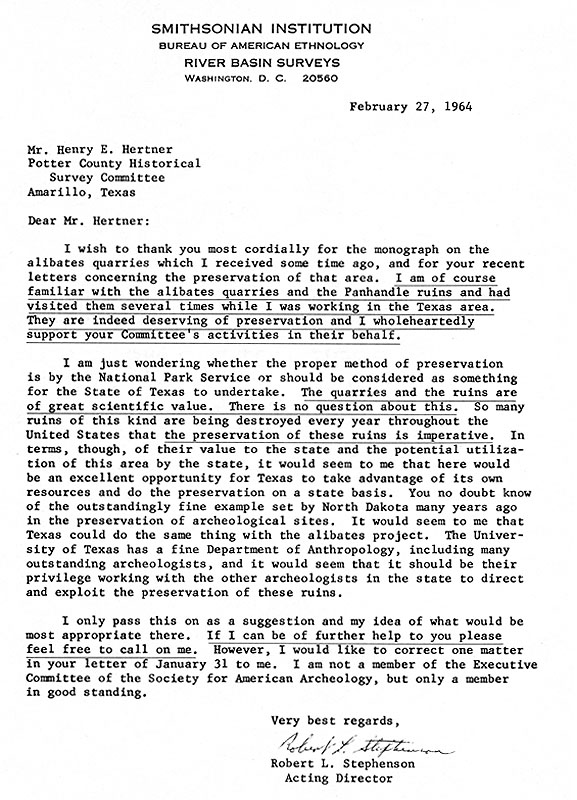
Letter from Smithsonian archeologist
Robert L. Stephenson, one of many pleading the case
for national monument status for the Alibates Quarries.
|
|
